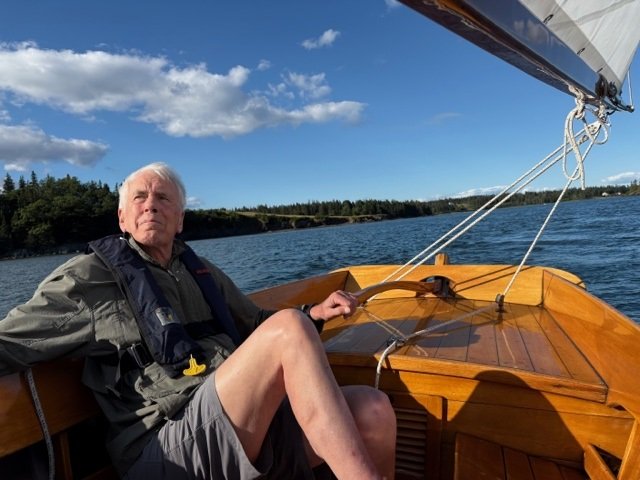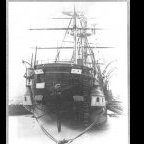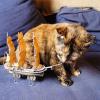Supplies of the Ship Modeler's Handbook are running out. Get your copy NOW before they are gone! Click on photo to order.
×
-
Posts
1,294 -
Joined
-
Last visited
Reputation Activity
-
 TBlack reacted to vossiewulf in Lula by Keith Black - FINISHED - 1:120 Scale - 1870s Sternwheeler Supply Boat for Floating Pile Driver
TBlack reacted to vossiewulf in Lula by Keith Black - FINISHED - 1:120 Scale - 1870s Sternwheeler Supply Boat for Floating Pile Driver
Sigh. Will be thinking about you. As for your decision, do the best you can- that's all you can do.
-
 TBlack reacted to Keith Black in Lula by Keith Black - FINISHED - 1:120 Scale - 1870s Sternwheeler Supply Boat for Floating Pile Driver
TBlack reacted to Keith Black in Lula by Keith Black - FINISHED - 1:120 Scale - 1870s Sternwheeler Supply Boat for Floating Pile Driver
I loved the stories behind the "mystery lady" it helped take my mind off my current situation.
Speaking of current situation, I received the CT Scan test results today and it confirms the ultrasound results done on April 15th. I've yet to speak with the doctor's office but going over the CTS results with the aid of Google explaining medical terminology, in essence the aorta sac has enlarged above the stent and an endoleak has developed below the stent. I assume the endoleak is causing the sac enlargement.
There's probably two options, surgical intervention and medication (lower blood pressure medication but I don't have high blood pressure) and monitoring. From what Google tells me surgery for men my age (78) is a bit risky. If surgery is 50/50 and monitoring and medication is 50/50, that's gonna make for a hard decision. We'll see once I talk to someone other than Mr Google.
I've pretty much done everything I can do around the house in preparation for whatever comes next so yesterday I started trying to make Lula's bell frame. 1.0 didn't go well, maybe I can find time in the morning to attempt 2.0?
Thank you ever so much to everyone for your thoughts and prayers. My journey is blessed because you folks are part of it. Thank you again.
Keith
-
 TBlack got a reaction from Canute in Lula by Keith Black - FINISHED - 1:120 Scale - 1870s Sternwheeler Supply Boat for Floating Pile Driver
TBlack got a reaction from Canute in Lula by Keith Black - FINISHED - 1:120 Scale - 1870s Sternwheeler Supply Boat for Floating Pile Driver
Keith, I think you've got 2 options: either she is part of the crew or she is a passenger in the car. But if she's a passenger then why climb up the ladder to get your picture taken. My inclination is that she belongs in the pilot house and has come out for the photo. The car is 1920's vintage and at that time wouldn't it have been unusual for women to wear pants?
Tom
-
 TBlack got a reaction from GrandpaPhil in Lula by Keith Black - FINISHED - 1:120 Scale - 1870s Sternwheeler Supply Boat for Floating Pile Driver
TBlack got a reaction from GrandpaPhil in Lula by Keith Black - FINISHED - 1:120 Scale - 1870s Sternwheeler Supply Boat for Floating Pile Driver
Keith, I think you've got 2 options: either she is part of the crew or she is a passenger in the car. But if she's a passenger then why climb up the ladder to get your picture taken. My inclination is that she belongs in the pilot house and has come out for the photo. The car is 1920's vintage and at that time wouldn't it have been unusual for women to wear pants?
Tom
-
 TBlack reacted to Paul Le Wol in Lula by Keith Black - FINISHED - 1:120 Scale - 1870s Sternwheeler Supply Boat for Floating Pile Driver
TBlack reacted to Paul Le Wol in Lula by Keith Black - FINISHED - 1:120 Scale - 1870s Sternwheeler Supply Boat for Floating Pile Driver
This is my take on the people in the photo. If the woman was the captain, she would be standing in the doorway of the pilot house wearing a big smile. She may be the captain’s wife/ daughter who had just brought him lunch. The captain is eating lunch in the pilot house because she wants to take the dishes home before they get underway again The man driving the car is a travelling salesman so the captain has to keep his eye on him during lunch. Those guys in the background are a whole other story.
-
 TBlack got a reaction from Paul Le Wol in Lula by Keith Black - FINISHED - 1:120 Scale - 1870s Sternwheeler Supply Boat for Floating Pile Driver
TBlack got a reaction from Paul Le Wol in Lula by Keith Black - FINISHED - 1:120 Scale - 1870s Sternwheeler Supply Boat for Floating Pile Driver
Keith, I think you've got 2 options: either she is part of the crew or she is a passenger in the car. But if she's a passenger then why climb up the ladder to get your picture taken. My inclination is that she belongs in the pilot house and has come out for the photo. The car is 1920's vintage and at that time wouldn't it have been unusual for women to wear pants?
Tom
-
 TBlack got a reaction from Keith Black in Lula by Keith Black - FINISHED - 1:120 Scale - 1870s Sternwheeler Supply Boat for Floating Pile Driver
TBlack got a reaction from Keith Black in Lula by Keith Black - FINISHED - 1:120 Scale - 1870s Sternwheeler Supply Boat for Floating Pile Driver
Keith, I think you've got 2 options: either she is part of the crew or she is a passenger in the car. But if she's a passenger then why climb up the ladder to get your picture taken. My inclination is that she belongs in the pilot house and has come out for the photo. The car is 1920's vintage and at that time wouldn't it have been unusual for women to wear pants?
Tom
-
 TBlack reacted to Keith Black in Lula by Keith Black - FINISHED - 1:120 Scale - 1870s Sternwheeler Supply Boat for Floating Pile Driver
TBlack reacted to Keith Black in Lula by Keith Black - FINISHED - 1:120 Scale - 1870s Sternwheeler Supply Boat for Floating Pile Driver
While sitting at my worktable this morning, reflecting and looking at a print of the photo below I had a thought...... I've always wondered about the woman sitting on the stairway to the pilothouse, who was she? She sits apart and above the men on deck. It has always seemed a bit odd that a woman would be part of the scene unless she was the captain/pilot/owner's wife whose name was Lula.
But, putting aside my male prejudiced, could she have been the captain/pilot/owner who named the ferry after herself? The only reason I don't think that's the case is because of her skirt and shoes, not your typical work attire but then.....it makes a great story and I wish that were the truth of it. Who were you mystery lady?
-
 TBlack got a reaction from Canute in Lula by Keith Black - FINISHED - 1:120 Scale - 1870s Sternwheeler Supply Boat for Floating Pile Driver
TBlack got a reaction from Canute in Lula by Keith Black - FINISHED - 1:120 Scale - 1870s Sternwheeler Supply Boat for Floating Pile Driver
Keith, So if you had the scan today, and it takes a couple of days for the results, does that mean Friday? In any event you need to share the results with us. You've included us as your family; no backing out now.
Tom
-
 TBlack got a reaction from Keith Black in Lula by Keith Black - FINISHED - 1:120 Scale - 1870s Sternwheeler Supply Boat for Floating Pile Driver
TBlack got a reaction from Keith Black in Lula by Keith Black - FINISHED - 1:120 Scale - 1870s Sternwheeler Supply Boat for Floating Pile Driver
Keith, So if you had the scan today, and it takes a couple of days for the results, does that mean Friday? In any event you need to share the results with us. You've included us as your family; no backing out now.
Tom
-
 TBlack got a reaction from Knocklouder in Lula by Keith Black - FINISHED - 1:120 Scale - 1870s Sternwheeler Supply Boat for Floating Pile Driver
TBlack got a reaction from Knocklouder in Lula by Keith Black - FINISHED - 1:120 Scale - 1870s Sternwheeler Supply Boat for Floating Pile Driver
Keith, So if you had the scan today, and it takes a couple of days for the results, does that mean Friday? In any event you need to share the results with us. You've included us as your family; no backing out now.
Tom
-
 TBlack reacted to lraymo in Lula by Keith Black - FINISHED - 1:120 Scale - 1870s Sternwheeler Supply Boat for Floating Pile Driver
TBlack reacted to lraymo in Lula by Keith Black - FINISHED - 1:120 Scale - 1870s Sternwheeler Supply Boat for Floating Pile Driver
Thinking of you today, Keith, and sending healing thoughts! Hope all goes well!
-
 TBlack reacted to Keith Black in Pelican 1943 by FriedClams - 1:48 - Eastern-Rig Dragger
TBlack reacted to Keith Black in Pelican 1943 by FriedClams - 1:48 - Eastern-Rig Dragger
That's neat metal working, Gary. Great construction details and explanation.
-
 TBlack reacted to FriedClams in Pelican 1943 by FriedClams - 1:48 - Eastern-Rig Dragger
TBlack reacted to FriedClams in Pelican 1943 by FriedClams - 1:48 - Eastern-Rig Dragger
Thank you, Keith A, Paul, Jacques, and Keith B, for your comments and support! And thanks to all for the "thumbs up".
I’ve begun work on the Pelicans’ four gallows frames and this post describes some of the preliminary work.
The purpose of these frames is to hang the heavy tow blocks slightly over the side of the boat at about 4 to 5 feet above the main rail. The blocks function as tow points for the trawl and are also used to deploy and retrieve the gear with the main winch.
The screenshot below shows one of the frames outlined in blue. The green lines point out three braces that structurally secures the frame to the boat.
There are no details of these frames provided on the plans, so I drew up my own from a few basic dimensions I pulled from the plans and from photos of period boats.
I took the drawing apart to provide cutting templates for the individual components. The main legs are Evergreen styrene “H” columns, and the top plates were cut from .010”(.25mm) styrene sheet.
The pieces were arranged on the assembly templates and solvent cemented together.
There are several different types of brackets required for each frame and I made them all from brass. After drawing them in CAD, I began by slicing brass sheet into strips of the required widths. In the past I’ve made strips using shears (which curls and deforms them), or by scoring and bending until it fatigue breaks. I’ve even used a guillotine style paper cutter that in certain situations works fairly well. But these methods are not very precise and with some of these strips being quite narrow (.073”(1.8mm)), I wanted to try something a little different.
I used a stainless steel sheet (cutting surface), a carpet knife, a stout straight edge, and 2” wide double sided masking tape (sticky on both sides.)
The secret sauce is the heavy duty masking tape. One piece of tape holds the brass to the stainless and a second piece holds the straight edge to the brass. The tape holds everything very tightly in place to the extent that the straight edge is quite difficult to remove and reposition for the next cut. One could easily bend and ruin a thin metal straight edge doing this.
The setup below is ready for slicing off a quarter inch strip, and as you see from the score marks in the stainless, I’ve already cut several strips of various widths.
The carpet knife is sharp, hard and stands up to abuse like this far better than a hobby knife blade. And due to its geometry, the blade is less likely to chip off, but needless to say I wore proper eye protection. I found repeated light cuts produces a better edge than trying to blast through it with only a few. The brass here is .008” (.2mm) thick, so it only took about seven passes to free the strip from the sheet. The passes feel sticky until the stainless is reached at which time the blade glides easily through. This does leave a bur along the cut edge, but a few swipes with a fine flat diamond file licks them right off.
First to be made are the six bracket pairs (12 total) that secure the gallows frame bracing to the whaleback or pilothouse structures.
The strip is stuck to the template with two-sided cellophane tape and the fold and cut lines are scratched on.
The bracket is clipped from the strip with flush-cut diagonals and the edges are eased with a diamond file.
A bolt hole is drilled through with a pin vise.
The piece is placed into a photo etch bender.
Positioned and squared up.
Then bent.
The gallows have brackets at their feet to allow them to tilt out over the rail.
Eight pairs (16 total) of these will be needed. Holes for the bolt shanks will be drilled later.
A pair of brace brackets on the back side of the frame.
A total of eight brackets are needed.
Each frame gets two chain cleats. Soldered phosphor bronze.
The rod that extends from the center of the cleat will be clipped to length once installed.
And the rod loop which the tow blocks will hang from.
More prep work to be done on these frames, but that's it for now.
Thanks for looking. Stay well.
Gary
-
 TBlack reacted to Canute in Lula by Keith Black - FINISHED - 1:120 Scale - 1870s Sternwheeler Supply Boat for Floating Pile Driver
TBlack reacted to Canute in Lula by Keith Black - FINISHED - 1:120 Scale - 1870s Sternwheeler Supply Boat for Floating Pile Driver
The cardio docs are tracking this via the echocardio tests and some blood test. The test measures an enzyme level that is a signpost for how hard your heart is working. My last test showed my heart improving with the stents and medication I'm taking. 👍 Used to be some serious operation opening the chest and heart to implant a new valve. Nowadays they can go thru an arm or femoral artery. And implant either a mechanical or animal based valve. The medical field has so many options now.
-
 TBlack got a reaction from Canute in Lula by Keith Black - FINISHED - 1:120 Scale - 1870s Sternwheeler Supply Boat for Floating Pile Driver
TBlack got a reaction from Canute in Lula by Keith Black - FINISHED - 1:120 Scale - 1870s Sternwheeler Supply Boat for Floating Pile Driver
Keith, dear brother, It's my view that in our lives on this planet we are given hurdles to get over, and how we deal with these hurdles defines who we are. You've been handling this hurdle exceptionally well....grace and style. I'm proud of you!
Tom
-
 TBlack got a reaction from Canute in Lula by Keith Black - FINISHED - 1:120 Scale - 1870s Sternwheeler Supply Boat for Floating Pile Driver
TBlack got a reaction from Canute in Lula by Keith Black - FINISHED - 1:120 Scale - 1870s Sternwheeler Supply Boat for Floating Pile Driver
Keith, dear brother, I’m going to read into the fact that the CT scan isn’t until 4/30 means we’ve got some swingin’ room. Stay positive. It’s the not knowing that’s the worst part. We’re all with you!
Tom
-
 TBlack got a reaction from Cathead in Lula by Keith Black - FINISHED - 1:120 Scale - 1870s Sternwheeler Supply Boat for Floating Pile Driver
TBlack got a reaction from Cathead in Lula by Keith Black - FINISHED - 1:120 Scale - 1870s Sternwheeler Supply Boat for Floating Pile Driver
Keith, dear brother, It's my view that in our lives on this planet we are given hurdles to get over, and how we deal with these hurdles defines who we are. You've been handling this hurdle exceptionally well....grace and style. I'm proud of you!
Tom
-
 TBlack reacted to Dr PR in pin vise and drill bits
TBlack reacted to Dr PR in pin vise and drill bits
1. If you will be using a hand held pin vise DO NOT get carbide bits. They are very brittle and break with the slightest twist. These are for use in milling machines, drill presses and PC board fabrication machines. High speed steel bits are good for pin vises.
Most of the bits I have seen with thick shafts and narrow cutting ends are carbide and are designed for automatic drilling machines.
2. Whatever you get, be sure it will hold the smallest bits (#80, 0.0135 inch, 0.34 mm). I have two of the types with removable collets and they will not hold the tiny bits.
I bought a set of four pin vises with the "collet" as part of the body. The smallest closes down to virtually zero diameter and holds the smallest drill bits tightly. The handle is a simple knurled cylindrical shaft that can be chucked into a drill press. The handle is hollow, and allows long bits, wires, needles, whatever, to be held by the pin vise. I don't recall where I got them, but the set wasn't very expensive. Almost certainly made in China.
3. These things are useful for holding anything small. In addition to drill bits I have used them to hold needles, pieces of wire with hooks in the end to help with rigging, and short pieces of jeweler's saw blades. Here is a photo of the smallest pin vise holding a piece of a jeweler's saw. I needed to make a cut with a very narrow kerf.
Having multiple pin vises means you can use one to hold the thing you are working on and another to hold the tool you are using. Or you can have multiple sizes of drill bits ready to use without changing collets.
4. The only drawback I have found with the hollow tube handle pin vises is that they do not have a finger rest on the end of the handle - just the end of the hollow tube. This is a bit uncomfortable when using a finger to press the tool as you are turning it to drill holes. I have thought about making one - perhaps adapting the rotating finger rest from one of my other pin vises that has multiple collets. Bit this hasn't been a big problem.
-
 TBlack reacted to Mike_H in Chris Watton and Vanguard Models news and updates Volume 2
TBlack reacted to Mike_H in Chris Watton and Vanguard Models news and updates Volume 2
Plus one vote for the template! Seems amazing to me that either the pear is sufficiently elastic or that the curvature in the vertical plane so slight that it will sit on the frames so well. But clearly it does!
-
 TBlack reacted to dunnock in HMS Speedy 1782 by dunnock - FINISHED - Vanguard Models - 1:64 Scale
TBlack reacted to dunnock in HMS Speedy 1782 by dunnock - FINISHED - Vanguard Models - 1:64 Scale
Anchors – The first job is to attached the anchor bouys. I used 0.35mm rope. A knot is tied in the rope and a seizing put on either side around the shank. A third seizing is added at the end of the shank nearest the crown. The rope is wound round the crown and the anchor bouy seized on the other end. The excess rope is coiled and two siezings added to hold the coils in place.
The bowers are attached to the cable by a clinch. The cable is taken through the ring from the front, wrapped around itself and secured with three seizings.
I decided to show one bower catted and with the stopper in place and the other fully tied in the chains. The other two anchors, spare anchor and sheet anchor, I think they are called, are tied up in the chains.
Finally I’ve added the ensign halliard using a 3mm double block at the peak and a single in the stern. This will now have to wait for a slot in my flag painter’s schedule to add the ensign. Other than that everything is there.
It only remains to tidy up the horses and lines by wetting them out with very dilute matt varnish and small weights.
The build has taken almost a year, a little longer than I expected – but I wasn’t in any hurry. I planked the upper bulwarks and stern in boxwood rather than using the patterns provided and I also planked the deck in boxwood and modified a few bits and pieces along the way.
I'll post a few more photos when it's all 'ship-shape'
In the meantime, thanks to everyone who has been following and for all the comments, help and encouragement - it has really been appreciated.
David
-
 TBlack got a reaction from Keith Black in Lula by Keith Black - FINISHED - 1:120 Scale - 1870s Sternwheeler Supply Boat for Floating Pile Driver
TBlack got a reaction from Keith Black in Lula by Keith Black - FINISHED - 1:120 Scale - 1870s Sternwheeler Supply Boat for Floating Pile Driver
Keith, dear brother, It's my view that in our lives on this planet we are given hurdles to get over, and how we deal with these hurdles defines who we are. You've been handling this hurdle exceptionally well....grace and style. I'm proud of you!
Tom
-
 TBlack got a reaction from Glen McGuire in Lula by Keith Black - FINISHED - 1:120 Scale - 1870s Sternwheeler Supply Boat for Floating Pile Driver
TBlack got a reaction from Glen McGuire in Lula by Keith Black - FINISHED - 1:120 Scale - 1870s Sternwheeler Supply Boat for Floating Pile Driver
Keith, dear brother, It's my view that in our lives on this planet we are given hurdles to get over, and how we deal with these hurdles defines who we are. You've been handling this hurdle exceptionally well....grace and style. I'm proud of you!
Tom
-
 TBlack got a reaction from Knocklouder in Lula by Keith Black - FINISHED - 1:120 Scale - 1870s Sternwheeler Supply Boat for Floating Pile Driver
TBlack got a reaction from Knocklouder in Lula by Keith Black - FINISHED - 1:120 Scale - 1870s Sternwheeler Supply Boat for Floating Pile Driver
Keith, dear brother, It's my view that in our lives on this planet we are given hurdles to get over, and how we deal with these hurdles defines who we are. You've been handling this hurdle exceptionally well....grace and style. I'm proud of you!
Tom
-
 TBlack reacted to dunnock in HMS Speedy 1782 by dunnock - FINISHED - Vanguard Models - 1:64 Scale
TBlack reacted to dunnock in HMS Speedy 1782 by dunnock - FINISHED - Vanguard Models - 1:64 Scale
Thanks everyone for the likes and kind comments - much appreciated.
Bowlines – This is the first model to which I’ve added bowlines and with all the other lines present it is quite a challenge. On reflection, I wish that I had added them to Diana I used 0.2mm line. Each bowline begins by being tied to the yard with a timberhitch. The foremast bowlines lead down through the blocks on the jib or bowsprit, through the saddle and to the bowsprit step.
The main mast bowlines again start from a timberhitch on the yard. The topgallant lines feed through holes in the fore topmast trestle trees, the topmast through the outer blocks on the foremast top and the main course through the blocks at the base of the foremast. All lines are tied off at the forward bitts.
To be honest I struggled to get them into their proper place so some lines just run to where I could reach. Maybe, I should have checked how all the ropes ran down to the bitts before starting the rigging, I would also have just trimmed the lines and left off all the hanks and coils until the end.
Well that completes the rigging which was by turns challenging and frustrating and the most complicated that I have tackled so far. There’s a lot of rope in a such a confined space. I’m glad that I'm not adding sails and their associated ropes.
It's hard to see all the smaller ropes but I'll take some better shots when she's finished.
David







